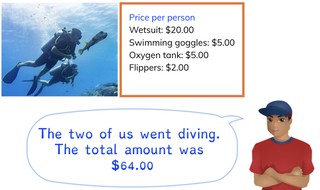
Solving math problems with multiple simple operations



8,000 schools use Gynzy
92,000 teachers use Gynzy
1,600,000 students use Gynzy
General
Students learn to calculate with multiple simple operations.
Standards
CCSS.Math.Content.5.OA.A.1
CCSS.Math.Content.5.OA.A.2
Learning objective
Students will be able to calculate multiple simple operations in a problem.
Introduction
Ask students to solve the given division problems.
Instruction
Explain to students that there are rules about the oder in which operations happen within a math problem. One of the rules is that you x and ÷ come before + and -. Multiplication and division are done before addition or subtraction. Show the example problem of 6 x 30 + 4 x 100. In this problem you multiply first and then add the numbers together. Show the next problem and read the story. Ask students to determine which numbers they need and to figure out which problems are addition and which ask for multiplication. Show which numbers are required to come to the problem 3 x 80 + 2 x 30. Remind students that they are flying in the morning, so they don't need to buy dinner in the airplane. Then solve the problem about Tony and friends. Ask students to solve the next problems individually or in pairs.
Check that students are able to solve problems with multiple simple operations by asking the following question:
- What order do you solve a problem that has x, ÷, +, and - ?
Quiz
Students are given problems in which they must determine how much money is spent in total, as take from a menu. They must also determine if the stated amount is enough to pay for all of the food. The problems involve multiple steps with simple operations. Remind students to multiply or divide before they add or subtract.
Closing
Discuss with students that it is important to learn how to solve problems with multiple operations. Then ask students to form pairs to solve the following problems. In the first exercise, students are asked to determine the total cost of an order and are given the task to determine which option is the cheapest. They are then given the task to determine what the difference is between the most expensive and the cheapest options available for a 3 course meal.
Teaching tips
Students who have difficulty with multiple simple operations can start by practicing with correctly determining what the problem is from the given information. Then ask them to solve the steps separately, for example by solving 3 x 10 = 30, and 4 x 10 = 40. Then ask them to solve those totals, 30 + 40 = 70. Then show how 3 x 10 + 4 x 10 = gives them the same total.
The online teaching platform for interactive whiteboards and displays in schools
Save time building lessons
Manage the classroom more efficiently
Increase student engagement
Discover more!
About Gynzy
Gynzy is an online teaching platform for interactive whiteboards and displays in schools.
With a focus on elementary education, Gynzy’s Whiteboard, digital tools, and activities make it easy for teachers to save time building lessons, increase student engagement, and make classroom management more efficient.



